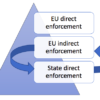Asylum
The Unexpected Resurrection of the Temporary Protection Directive following Russia’s invasion of Ukraine
The unprecedented activation of the 2001 Temporary Protection Directive in the wake of the Russian invasion of Ukraine has been welcomed as a ‘smart and pragmatic response of the EU institutions’. In this post, Salvatore Nicolosi (with the assistance of Francesca Bertin) suggests a more cautious approach, highlighting the risk of States using alternative protection labels based on emergency legislative measures to downgrade their obligations under international and EU refugee law, while generating a fictitious sense of solidarity.
Dr Nicolosi’s post is the first in a series drawing on a RENFORCE expert seminar on the EU’s response to the war in Ukraine, held online on 8th March 2022. Stay tuned to RENFORCE Blog for further analysis of the EU’s decision to provide weapons to Ukraine, the EU’s neighbourhood policies and Ukraine, the EU’s economic sanctions against Russia and the Ukraine war in the media.
Read more
The New Pact on Migration and Asylum: a paradigm shift in regulation and enforcement?
Salvatore Nicolosi and Paul Minderhoud
Last September 2020, the European Commission unveiled the New Pact on Migration and Asylum to commit the EU and its Member States ‘to build a system that manages and normalises migration for the long term.’ A fierce criticism has been already raised by scholars and civil society, claiming that this political platform is all but new and definitely unfit for the ‘fresh start’ sought by the Commission. In an attempt to contribute to this thriving debate, this post raises doubts on whether the Pact constitutes an effective paradigm shift in regulation and enforcement for EU asylum and migration law. As will be illustrated, the Pact reflects a regulatory framework that does not fix the existing divergences between the Member States, while at the enforcement level the approach is still precarious both as to the role of EU agencies and a strategy to ensure Member States compliance.
Read more
In search for an enforcement strategy for the Common European Asylum System
By Salvatore Nicolosi
The reform of the Common European Asylum System (CEAS) is one of the major regulatory challenges to the European Union (EU), which has continuously attracted academic attention (Nicolosi, 2019). Less consideration has been given to the dynamics of enforcement of that policy. Yet, this is a crucial issue, as acknowledged by the European Commission, the migratory pressure of the most recent years stressed the ‘structural weaknesses and shortcomings in the design and implementation of European asylum and migration policy.’ Apart from a ‘protracted implementation deficit,’ EU asylum law has been suffering from a ‘protracted compliance deficit’ (Thym, 2017). This makes the need for a more effective enforcement strategy all the more urgent. This post, therefore, aims to explain whether EU direct enforcement mechanisms can be more effective than traditional forms of enforcement by State authorities.
Read more
The Reform of the Common European Asylum System: Between Recast and New Regulation
By Salvatore Nicolosi
Twenty years after the European Council of Tampere that in 1999 set out the political roadmap to establish a Common European Asylum System (CEAS), the European Union and its Member States still struggle to design a solid and future-proof system. The migratory pressure on the EU increases the need for effective responses. With more than 1 million people reaching Europe in 2015 and more than 18,000 drowning at sea in the period between 2014 and 2019, a solid asylum system becomes all the more urgent.
The reform of the CEAS certainly constitutes a relevant context to reflect on the dynamics of regulation in a particular sensitive area of European integration. Nonetheless, a closer look at the ongoing reform illustrates how this lays behind the actual way forward to the realisation of the goals established in Tampere twenty years ago.
Read more
